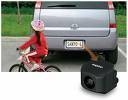
Rear-view mirrors allow drivers to view a large portion of the area behind their vehicles. However, trunks and rear decks often limit the view of the road as much as ten to 15 feet behind the vehicle. Rear-view cameras, also known as "reversing cameras" or "backup cameras," resolve this problem. These cameras enable drivers to see objects and people directly behind their vehicles.

The structure of a rear-view camera is different from other cameras. The reflection of a rear-view camera is horizontally flipped so that it produces a mirrored image. This is essential because the driver and the rear-view camera are in opposite positions. The mirrored image is also necessary because it causes the direction of the display to be constant with the mirrors mounted on the motor vehicle. The rear-view camera display is usually wired to automatically sense when the transmission is set in reverse, and it shows the rear view while the car is in reverse. The other items in the rear of the vehicle are also shown at all times. The rear-view camera usually consists of a wide-angle or fish-eye lens. Although the lens doesn't allow the camera to view distant objects, it does permit the camera to view a continuous horizontal view from one corner, behind the car, to another. Rear-view cameras are also generally mounted at a downward angle. This allows the camera to show potential barriers on the ground in addition to the location and position of walls and docks that may be looming around the corner.

Rear-view camera systems are generally mounted to the lower outside areas of the vehicle or to the vehicle's bumper. With the camera mounted in these locations, it allows greater visibility. The rear-view camera display is often mounted inside the vehicle on either the sun visor or within the dash board area. Rear-view camera systems can be purchased as either wireless or wired back-up systems. In wired systems, the camera is linked to the display monitor via a long cable wire. In wireless systems, images are transformed to radio signals, transmitted and then converted from a radio signal back to a video image once it reaches the receiver and monitor.
Wired systems such as portable rear-view camera systems or semi-permanent, all-in-one back up camera systems, for example, are generally sold to consumers who have smaller vehicles. These portable units include small display screens. The screen is easily attached to the sun visor and has a lengthy wire that connects to the camera.
Because signals have to be converted via the airways with wireless systems, they sometimes receive interference from other wireless components as well as poor signal reception. As a result, many believe that much better quality is received with wired systems.
